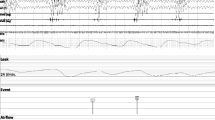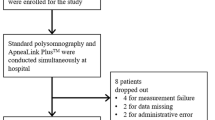Abstract
Objective
The aim of the study was to validate the automatic and manual analysis of ApneaLink Ox™ (ALOX) in patients with suspected obstructive sleep apnea (OSA).
Methods
All patients with suspected OSA had a polysomnography (PSG) and an ALOX performed in the sleep laboratory. For automatic analysis, hypopnea was defined as a decrease in airflow ≥30 % of baseline for at least 10 s plus oxygen desaturation ≥3 or 4 %. While for the manual analysis, hypopnoea was considered when a reduction of airflow ≥30 % of ≥10 s plus oxygen desaturation ≥3 % or increase in cardiac rate ≥5 beats/min were identified or, when only a reduction of airflow ≥50 % was observed. OSA was defined as a respiratory disturbance index (RDI) ≥5. The apnea/hypopnea automatic index (AHI3-a, AHI4-a) and manual index were estimated. Receiver operating characteristics (ROC) analysis and the agreement between ALOX and PSG were performed.
Results
Fifty-five patients were included (38 men; mean age, 48.2; median, RDI 15.1; median BMI, 30 Kg/m2). The automatic analysis of ALOX under-estimated the RDI from PSG, mainly for the criterion of oxygen desaturation ≥4 % (AHI3-a–RDI, −3.6 ± 10.1; AHI4-a–RDI, −6.5 ± 10.9, p < 0.05). The autoscoring from ALOX device showed a better performance when it was set up to identify hypopneas with an oxygen desaturation criterion of ≥3 % than when it was configured with an oxygen desaturation criterion of ≥4 % (area under the receiver operator curves, 0.87 vs. 0.84). Also, the manual analysis was found to be better than the autoscoring set up with an oxygen desaturation of ≥3 % (0.923 vs. 0.87). The manual analysis showed a good interobserver agreement for the classification of patients with or without OSA (k = 0.81).
Conclusion
The AHI obtained automatically from the ApneaLink Ox™ using oxygen desaturation ≥3 % as a criterion of hypopnea had a good performance to diagnose OSA. The manual scoring from ApneaLink Ox™ was better than the automatic scoring to discriminate patients with OSA.




Similar content being viewed by others
References
Young T, Peppard PE, Gottlieb DJ (2002) Epidemiology of obstructive sleep apnea: a population health perspective. Am J Respir Crit Care Med 165:1217–1239
Huang SG, Li QY (2003) Prevalence of obstructive sleep apnea/hypopnea syndrome in Chinese adults aged over 30 yr in Shanghai. Zhonghua Jie He He Hu Xi Za Zhi 26:268–272
Ip MS, Lam B, Lauder IJ, Tsang KW, Chung KF, Mok YW, Lam WK (2001) A community study of sleep disordered breathing in middle-aged Chinese men in Hong Kong. Chest 119:62–69
Sharma SK, Kumpawat S, Banga A, Goel A (2006) Prevalence and risk factors of obstructive sleep apnea syndrome in a population of Delhi, India. Chest 130:149–156
Caterson ID, Hubbard V, Bray GA, Grunstein R, Hansen BC, Hong Y, Labarthe D, Seidell JC, Smith SC Jr (2004) Prevention Conference VII: obesity, a worldwide epidemic related to heart disease and stroke: Group III: worldwide comorbidities of obesity. Circulation 110:e476–e483
Peppard PE, Young T, Palta M, Skatrud J (2000) Prospective study of the association between sleep-disordered breathing and hypertension. N Engl J Med 342:1378–1384
Newman AB, Nieto J, Guirdry U, Lind BK, Redline S, Pickering TG, Quan SF, Sleep Heart Health Study Research Group (2001) Relation of sleep-disordered breathing to cardiovascular risk factors. Am J Epidemiol 154:50–59
Lavie P, Herer P, Peled R, Berger I, Yoffe N, Zomer J, Rubin AH (1995) Mortality in sleep apnoea patients; multivariate analysis of risk factors. Sleep 18:149–157
No authors listed (1997) Practice parameters for the indications for polysomnography and related procedures. Polysomnography Task Force, American Sleep Disorders Association Standards of Practice Committee. Sleep 20:406–422
Flemons WW, Douglas NJ, Kuna ST, Rodenstein DO, Wheatley J (2004) Access to diagnosis and treatment of patients with suspected sleep apnea. Am J Respir Crit Care Med 169:668–672
Ferber R, Millman R, Coppola M, Fleetham J, Murray CF, Iber C, McCall V, Nino-Murcia G, Pressman M, Sanders M (1994) Portable recording in the assessment of obstructive sleep apnea. ASDA standards of practice. Sleep 17:378–392
Erman MK, Stewart D, Einhorn D, Gordon N, Casal E (2007) Validation of the ApneaLink for the screening of sleep apnea: a novel and simple single-channel recording device. J Clin Sleep Med 3:387–392
Chen H, Lowe AA, Bai Y, Hamilton P, Fleetham JA, Almeida FR (2009) Evaluation of a portable recording device (ApneaLink) for case selection of obstructive sleep apnea. Sleep Breath 13:213–219
Ragette R, Wang Y, Weinreich G, Teschler H (2010) Diagnostic performance of single airflow channel recording (ApneaLink) in home diagnosis of sleep apnea. Sleep Breath 14:109–114
Nigro CA, Dibur E, Aimaretti S, González S, Rhodius E (2011) Comparison of the automatic analysis versus the manual scoring from ApneaLink™ device for the diagnosis of obstructive sleep apnoea syndrome. Sleep Breath 15:679–686
Oktay B, Rice TB, Atwood CW Jr, Passero M Jr, Gupta N, Givelber R, Drumheller OJ, Houck P, Gordon N, Strollo PJ Jr (2011) Evaluation of a single-channel portable monitor for the diagnosis of obstructive sleep apnea. J Clin Sleep Med 7:384–390
BaHammam AS, Sharif M, Gacuan DE, George S (2011) Evaluation of the accuracy of manual and automatic scoring of a single airflow channel in patients with a high probability of obstructive sleep apnea. Med Sci Monit 17:MT13–MT19
Weinreich G, Armitstead J, Töpfer V, Wang YM, Wang Y, Teschler H (2009) Validation of ApneaLink as screening device for Cheyne–Stokes respiration. Sleep 32:553–557
Gantner D, Ge JY, Li LH, Antic N, Windler S, Wong K, Heeley E, Huang SG, Cui P, Anderson C, Wang JG, McEvoy D (2010) Diagnostic accuracy of a questionnaire and simple home monitoring device in detecting obstructive sleep apnoea in a Chinese population at high cardiovascular risk. Respirology 15:952–960
Chai-Coetzer CL, Antic NA, Rowland LS, Catcheside PG, Esterman A, Reed RL, Williams H, Dunn S, McEvoy RD (2011) A simplified model of screening questionnaire and home monitoring for obstructive sleep apnoea in primary care. Thorax 66:213–219
Areias V, Romero J, Cunha K, Faria R, Mimoso J, Gomes V, Brito U (2012) Sleep apnea-hypopnea syndrome and acute coronary syndrome—an association not to forget. Rev Port Pneumol 18:22–28
Rechtschafen A, Kales A (1968) A manual of standarized technology, techniques and scoring system for sleep stages of human subjects. Brain Information Service, Brain Information Institute, University of California, Los Angeles
Atlas Task Force of the ASD (1992) EEG arousals: scoring rules and examples. Sleep 15:174–184
Consenso Nacional sobre el Síndrome Apneas-Hipopneas del Sueño del Grupo Español de Sueño (2005) Definición y concepto, fisiopatología, clínica y exploración del SAHS. Arch bronconeumol 41 Extraordinario 4:12–29
Ayappa I, Norman RG, Krieger AC, Rosen A, O'malley RL, Rapoport DM (2000) Non-invasive detection of respiratory effort-related arousals (REras) by a nasal cannula/pressure transducer system. Sleep 23:763–771
Sala H, Nigro C, Rabec C, Guardia AS, Smurra M (2001) Consenso Argentino de Trastornos Respiratorios Vinculados al Sueño. Medicina 61:351–363
Guilleminault C, Bassiri A (2005) Clinical features and evaluation of obstructive sleep apnea-hypopnea syndrome and upper airway resistance syndrome. In: Kryger MH, Roth T, Dement WC (eds) Principles and practice of sleep medicine, 4th edn. Elsevier, Philadelphia, pp 1043–1052
Farré R, Rigau J, Montserrat JM, Ballester E, Navajas D (2001) Relevance of linearizing nasal prongs for assessing hypopneas and flow limitation during sleep. Am J Respir Crit Care Med 163:494–497
Winkelman JW (1999) The evoked heart rate response to periodic leg movements of sleep. Sleep 22:575–580
Somers VK, Javaheri S (2005) Cardiovascular effects of sleep related breathing disorders. In: Kryger MH, Roth T, Dement WC (eds) Principles and practice of sleep medicine, 4th edn. Elsevier, Philadelphia, pp 1180–1191
Pita Fernández S, Pértega Díaz S (2003) Pruebas diagnósticas. Cad Aten Primaria 10:120–124
Koziej M, Cieslicki JK, Gorzelak K, Sliwinski P, Zielinski J (1994) Hand-scoring of MESAM 4 recordings is more accurate than automatic analysis in screening for obstructive sleep apnoea. Eur Respir J 7:1771–1775. doi:10.1183/09031936.94.07101771
Esnaola S, Duran J, Infante-Rivard C, Rubio R, Fernandez A (1996) Diagnostic accuracy of a portable recording device (MESAM IV) in suspected obstructive sleep apnoea. Eur Respir J 9:2597–2605
Calleja JM, Esnaola S, Rubio R, Duran J (2002) Comparison of a cardiorespiratory device versus polysomnography for diagnosis of sleep apnoea. Eur Respir J 20:1505–1510
Dingli K, Coleman EL, Vennelle M, Finch SP, Wraith PK, Mackay TW, Douglas NJ (2003) Evaluation of a portable device for diagnosing the sleep apnoea/hypopnoea syndrome. Eur Respir J 21:253–259
Acknowledgments
The authors wish to thank Ms. Jaquelina Mastantuono for revising the English text.
Disclosure of financial support
None.
Disclosure of any conflicts of interest
Carlos A. Nigro received two ApneaLink Ox devices by the company AirLiquide Argentina to perform this study.
Author information
Authors and Affiliations
Corresponding author
Rights and permissions
About this article
Cite this article
Nigro, C.A., Dibur, E., Malnis, S. et al. Validation of ApneaLink Ox™ for the diagnosis of obstructive sleep apnea. Sleep Breath 17, 259–266 (2013). https://doi.org/10.1007/s11325-012-0684-4
Received:
Revised:
Accepted:
Published:
Issue Date:
DOI: https://doi.org/10.1007/s11325-012-0684-4




